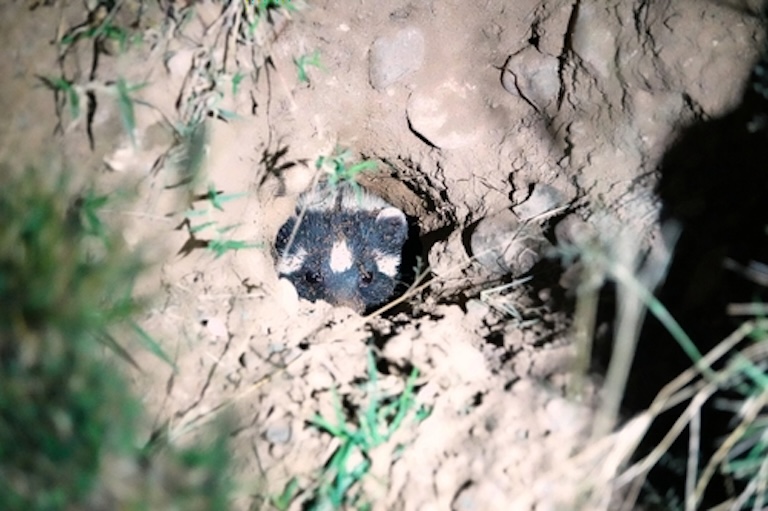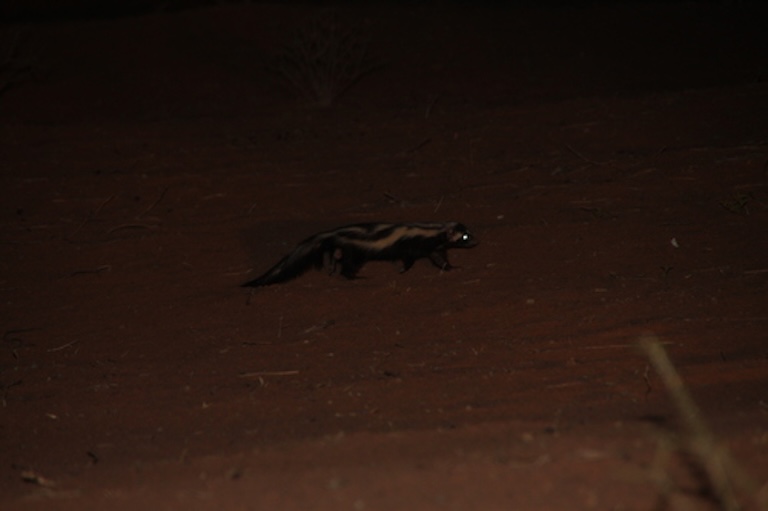Zorilla Profile
Every day is a good day when we get to talk about Mustelidae. And today must be an excellent day because we get to talk about two of them!
Zorillas are not half gorilla, but are perhaps half zebra. Unfortunately for their enemies, the other half is pure mustelid.

Zorilla Facts Overview
| Habitat: | Moist, uncovered environments, savanna, desert, shrubland and grasslands |
| Location: | Sub-Saharan Africa |
| Lifespan: | 4-5 in the Wild, up to 13 in captivity |
| Size: | 30–38 cm (12–15 in), with a 30 cm tail) |
| Weight: | Up to 1.4 kg (3.1 lb) |
| Color: | Black and white |
| Diet: | Generalist predator of small animals |
| Predators: | Few; possibly hyenas on occasion |
| Top Speed: | Not known |
| No. of Species: | 2 |
| Conservation Status: | Least Concern |
The Zorilla is actually a common name for two very closely-related animals from Africa. Both look, smell and elicit cuteness noises like a skunk, but in fact they’re from a totally different family.
A family that is woefully under-appreciated, and absolutely packed with killers.
Interesting Zorilla Facts
1. It looks like a skunk
The zorilla technically comes in two forms. One is the striped polecat, Ictonyx striatus; the other is the African striped weasel, Poecilogale albinucha.
Both of these animals are low to the ground, black and white, and adorably fluffy. They fit the description of a skunk, yet are in fact very unrelated.
Both of these species are mustelids, the bear-like mesopredators that terrorise small mammals all over the world. Mustelids are perhaps the greatest animals the mammalian order has put forward to date, at least as far as fighting spirit goes.
Some can take on animals up to ten times their own mass, and they’re also just really cute and intelligent animals. Both of these examples are closely related, and both are commonly called Zorillas, but the polecat is the more commonly referred to as such.
Interestingly, while they are not skunks, they can and do smell like them.

2. And smells like a skunk
Both the stiped polecat and the African weasel share a common defense mechanism with the skunk.
Next to their anuses are some glands which can project a nauseating, even irritating, smelly fluid up to a metre outwards.
The skunky colours, therefore, seem to be a universal language for “Watch out for my butt”.
As a fun little side note: there is also a brand of cologne called Zorilla, which, according to their own marketing, “Smells sexy and masculine”. We have no idea how it compares with the smells of African mustelid, but hopefully it is unrelated. Having said that, 50% of its reviews on Amazon rate it at 1 star and one specifies: “Very strong smell that gave me a headache when used”, so… maybe not?
And if smelling terrible doesn’t work, the striped polecat predends to be dead. If that doesn’t work, it’s likely not to have to pretend for much longer.
While both of these animals do have predators, their roles are far more impressive as predators themselves. 1
3. They’re killers
We probably don’t need to keep pointing this out on mustelid profiles, but since it’s fun, and also important, to do these little predators justice, let’s do it again.
There’s a lot of potential for competition among the African mesopredators. You’ve got civets, genets, mongooses, and jackals, to name just a few. And then, there’s the other type of zorillo, too, which is probably the only animal tough enough to be a threat.
But both genera of these incredible mustelids are very good at avoiding such conflicts. First, they avoid one another by not sharing the exact same habitats. Then, they kill slightly different things.
African striped weasels tackle rodents of artound the same size as they are. The striped polecat appears to have a more varied diet including insects, reptiles and birds, as a side order to their rodent mains.
The polecat isn’t generally as bold when it comes to larger animal prey, but almost to the contrary of this, they have on rare occasions, been witnessed going for animals as large as an antelope. 2
5. Honey badger energy
If you’re thinking that this sort of brutal, no-shits-given approach to life sounds like another medium-sized African mammal, you’d be right. And for good reason.
Honey badgers, like Zorillas, are mustelids. And while honey badgers put most of their character points into defence, rather than attack, zorillas bring that energy to their victims.
Prey is dispatched with piercing bites to the spine, brain case or throat, and they get most of their hydration simply from the blood and fluids of their prey.
Like the honey badger, they’re mostly solitary, but can form small bands of up to four, if they feel like it.
6. They get their point across
Despite being mostly unsociable, Zorillos can communicate pretty clearly when they have to.
They have a range of verbal tools, including a sort of vibrating, oscillating call which can either mean hello or stay away, depending on how fast it’s happening.
They also scream quite well, which is a pretty universal language for “leave me alone”, and if all that fails there are visual cues like the raised back, lifted tail and concerningly angled anus.
And of course, the clearest message of all can be sprayed very convincingly if the prior intent hasn’t been fully appreciated.
7. They’re doing ok
Very few mustelids are struggling to survive, on account of them being so tenacious and mean. The European mink is the exception, and likely has it the hardest of all in the family, and sea otters are in trouble due to humans removing all the fish from the oceans, but animals like the Zorilla are doing well, and as mesopreators actually stand to outlast the larger predators in the ecosystem, even as it collapses.
So, for now, at least, Zorillas are one of Africa’s stable and successful predatory mammals, and hopefully it will remain that way! 3
Zorilla Fact-File Summary
Scientific Classification
| Kingdom: | Animalia |
| Phylum: | Chordata |
| Class: | Mammalia |
| Order: | Carnivora |
| Family: | Mustelidae |
| Genus: | Ictonyx/Poecilogale |
| Species Name: | Striatus/albinucha |
Fact Sources & References
- World Book (2016), “Zorilla’s Big Stink”, World Book.
- (2008), “Zorilla Warfare”, Karisia Walking Safari.
- IUCN (2015), “Zorilla”, IUCN.
